load capacity SKODA SUPERB 2010 2.G / (B6/3T) Owner's Manual
[x] Cancel search | Manufacturer: SKODA, Model Year: 2010, Model line: SUPERB, Model: SKODA SUPERB 2010 2.G / (B6/3T)Pages: 287, PDF Size: 16.59 MB
Page 17 of 287
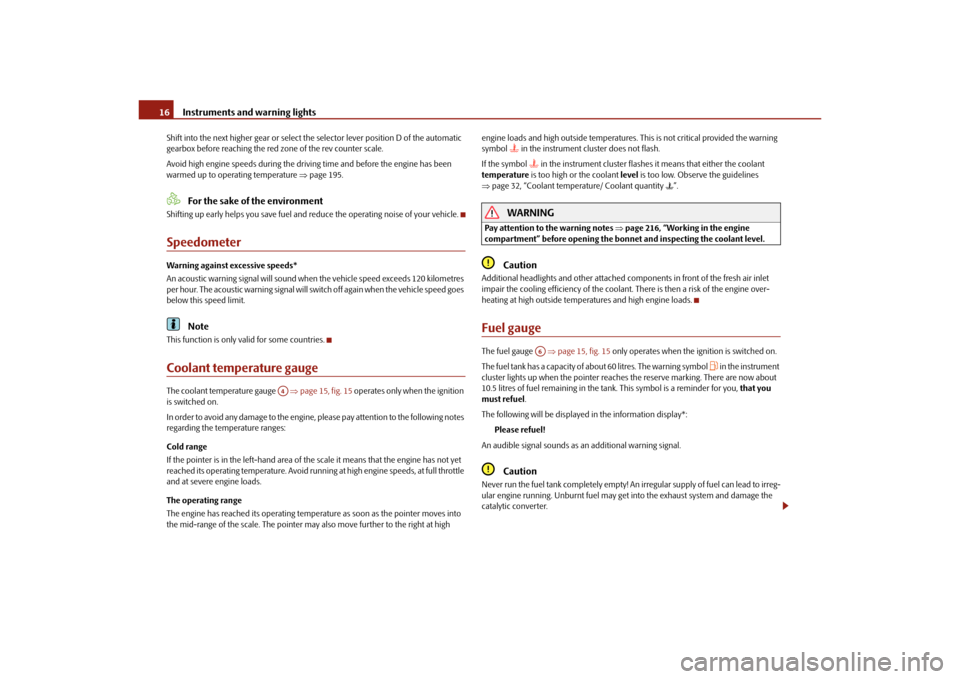
Instruments and warning lights
16
Shift into the next higher gear or select th e selector lever position D of the automatic
gearbox before reaching the red zone of the rev counter scale.
Avoid high engine speeds du ring the driving time and before the engine has been
warmed up to operating temperature page 195.
For the sake of the environment
Shifting up early helps you sa ve fuel and reduce the operating noise of your vehicle.SpeedometerWarning against excessive speeds*
An acoustic warning signal will sound when the vehicle speed exceeds 120 kilometres
per hour. The acoustic warning signal will switch off again when the vehicle speed goes
below this speed limit.
Note
This function is only valid for some countries.Coolant temperature gaugeThe coolant temperature gauge page 15, fig. 15 operates only when the ignition
is switched on.
In order to avoid any damage to the engine, please pay attention to the following notes
regarding the temperature ranges:
Cold range
If the pointer is in the left-hand area of the scale it means that the engine has not yet
reached its operating temperatur e. Avoid running at high engine speeds, at full throttle
and at severe engine loads.
The operating range
The engine has reached its operating temper ature as soon as the pointer moves into
the mid-range of the scale. The pointer may also move further to the right at high engine loads and high outside temperatures. This is not critical provided the warning
symbol
in the instrument cl
uster does not flash.
If the symbol in the instrument cluster flashes it means that either the coolant
temperature is too high or the coolant level is too low. Observe the guidelines
page 32, “Coolant temperature/ Coolant quantity ”.
WARNING
Pay attention to the warning notes page 216, “Working in the engine
compartment” before opening the bonn et and inspecting the coolant level.
Caution
Additional headlights and other attached components in front of the fresh air inlet
impair the cooling efficiency of the coolant. There is then a risk of the engine over-
heating at high outside temper atures and high engine loads.Fuel gaugeThe fuel gauge page 15, fig. 15 only operates when the ignition is switched on.
The fuel tank has a capacity of about 60 litres. The warning symbol
in the instrument
cluster lights up when the pointer reaches the reserve marking. There are now about
10.5 litres of fuel remaining in the ta nk. This symbol is a reminder for you, that you
must refuel .
The following will be displayed in the information display*: Please refuel!
An audible signal sounds as an additional warning signal.
Caution
Never run the fuel tank completely empty! An irregular supply of fuel can lead to irreg-
ular engine running. Unburnt fuel may get into the exhaust system and damage the
catalytic converter.
A4
A6
s3fg.2.book Page 16 Friday, April 30, 2010 12:17 PM
Page 88 of 287
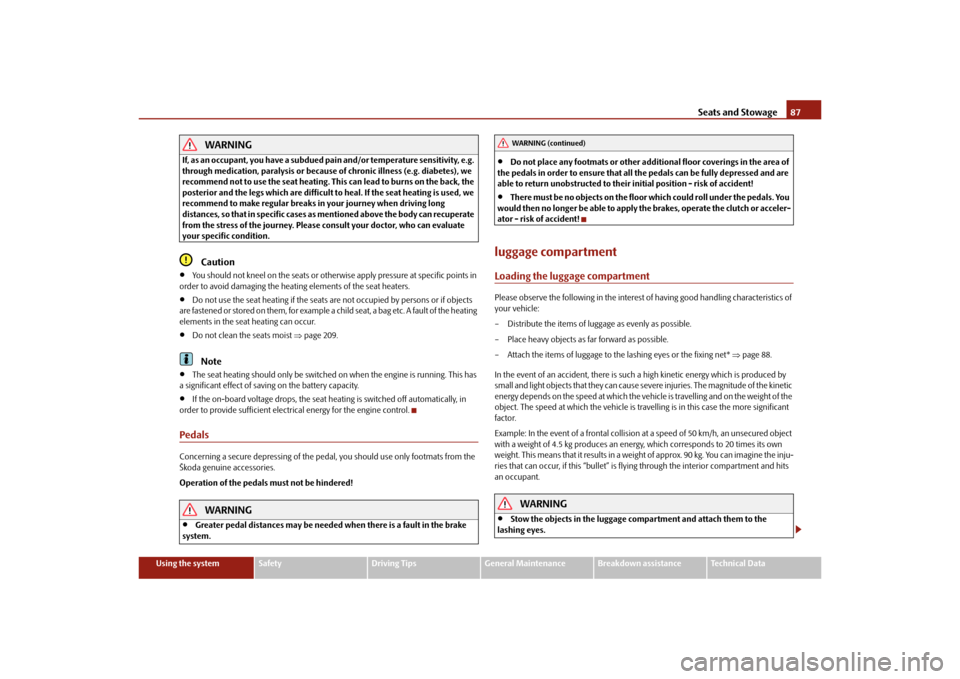
Seats and Stowage87
Using the system
Safety
Driving Tips
General Maintenance
Breakdown assistance
Technical Data
WARNING
If, as an occupant, you have a subdued pain and/or temp erature sensitivity, e.g.
through medication, paralysis or because of chronic illness (e.g. diabetes), we
recommend not to use the seat heating. Th is can lead to burns on the back, the
posterior and the legs which are difficult to heal. If the seat heating is used, we
recommend to make regular breaks in your journey when driving long
distances, so that in specific cases as mentioned above the body can recuperate
from the stress of the journey. Please consult your doctor, who can evaluate
your specific condition.
Caution
You should not kneel on the seats or otherwise apply pressure at specific points in
order to avoid damaging the heating elements of the seat heaters.
Do not use the seat heating if the seats are not occupied by persons or if objects
are fastened or stored on them, for example a child seat, a bag etc. A fault of the heating
elements in the seat heating can occur.
Do not clean the seats moist page 209.Note
The seat heating should only be switched on when the engine is running. This has
a significant effect of saving on the battery capacity.
If the on-board voltage drops, the seat heating is switched off automatically, in
order to provide sufficient electrical energy for the engine control.
PedalsConcerning a secure depressing of the peda l, you should use only footmats from the
Škoda genuine accessories.
Operation of the pedals must not be hindered!
WARNING
Greater pedal distances may be needed when there is a fault in the brake
system.
Do not place any footmats or other additional floor coverings in the area of
the pedals in order to ensure that all the pedals can be fully depressed and are
able to return unobstructed to their initial position - risk of accident!
There must be no objects on the floor which could roll under the pedals. You
would then no longer be able to apply the brakes, operate the clutch or acceler-
ator - risk of accident!
luggage compartmentLoading the luggage compartmentPlease observe the following in the interest of having good handling characteristics of
your vehicle:
– Distribute the items of luggage as evenly as possible.
– Place heavy objects as far forward as possible.
– Attach the items of luggage to the lashing eyes or the fixing net* page 88.
In the event of an accident, there is such a high kinetic energy which is produced by
small and light objects that they can cause severe injuries. The magnitude of the kinetic
energy depends on the speed at which the vehicle is travelling and on the weight of the
object. The speed at which the vehicle is trave lling is in this case the more significant
factor.
Example: In the event of a frontal collision at a speed of 50 km/h, an unsecured object
with a weight of 4.5 kg produces an en ergy, which corresponds to 20 times its own
weight. This means that it results in a weight of approx. 90 kg. You can imagine the inju-
ries that can occur, if this “bullet” is flying through the interior compartment and hits
an occupant.
WARNING
Stow the objects in the luggage compartment and attach them to the
lashing eyes.WARNING (continued)
s3fg.2.book Page 87 Friday, April 30, 2010 12:17 PM
Page 98 of 287
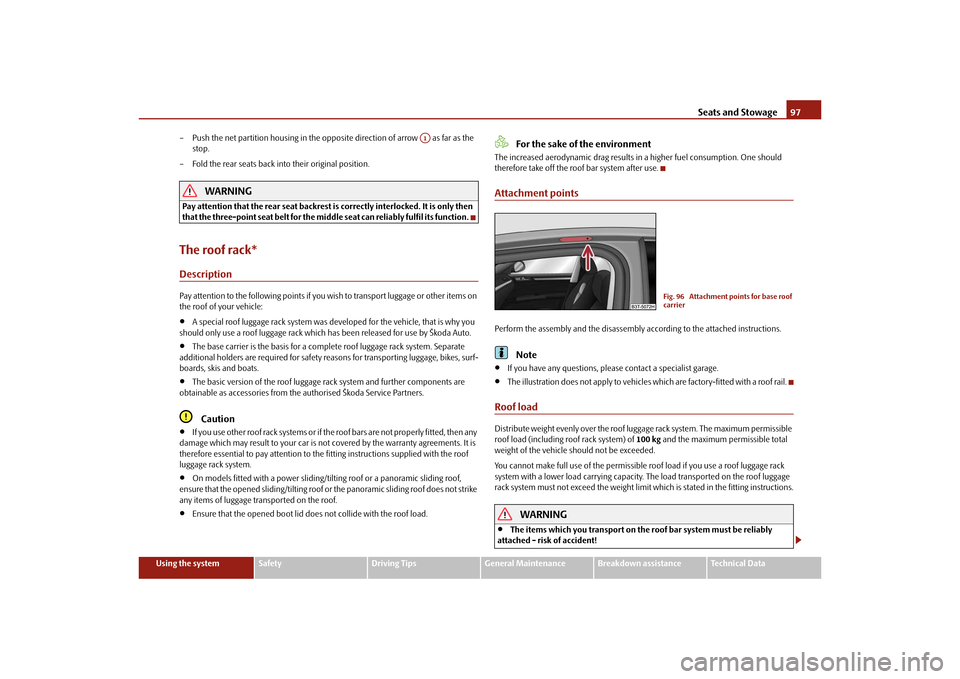
Seats and Stowage97
Using the system
Safety
Driving Tips
General Maintenance
Breakdown assistance
Technical Data
– Push the net partition housing in the oppo
site direction of arrow as far as the
stop.
– Fold the rear seats back into their original position.
WARNING
Pay attention that the rear seat backrest is correctly interlocked. It is only then
that the three-point seat belt for the middle seat can reliably fulfil its function.The roof rack*DescriptionPay attention to the following points if you wish to transport luggage or other items on
the roof of your vehicle:
A special roof luggage rack system was de veloped for the vehicle, that is why you
should only use a roof luggage rack which has been released for use by Škoda Auto.
The base carrier is the basis for a complete roof luggage rack system. Separate
additional holders are required for safety reasons for transporting luggage, bikes, surf-
boards, skis and boats.
The basic version of the roof luggage rack system and further components are
obtainable as accessories from the authorised Škoda Service Partners.Caution
If you use other roof rack systems or if the roof bars are not properly fitted, then any
damage which may result to your car is not covered by the warranty agreements. It is
therefore essential to pay attention to the fitting instructions supplied with the roof
luggage rack system.
On models fitted with a power sliding/ti lting roof or a panoramic sliding roof,
ensure that the opened sliding/tilting roof or the panoramic sliding roof does not strike
any items of luggage transported on the roof.
Ensure that the opened boot lid does not collide with the roof load.
For the sake of the environment
The increased aerodynamic drag results in a higher fuel consumption. One should
therefore take off the roof bar system after use.Attachment pointsPerform the assembly and the disassembly according to the attached instructions.
Note
If you have any questions, please contact a specialist garage.
The illustration does not apply to vehicles which are factory-fitted with a roof rail.
Roof loadDistribute weight evenly over the roof luggage rack system. The maximum permissible
roof load (including roof rack system) of 100 kg and the maximum permissible total
weight of the vehicle should not be exceeded.
You cannot make full use of th e permissible roof load if you use a roof luggage rack
system with a lower load carr ying capacity. The load transported on the roof luggage
rack system must not exceed the weight limit which is stated in the fitting instructions.
WARNING
The items which you transport on the roof bar system must be reliably
attached - risk of accident!
A1
Fig. 96 Attachment points for base roof
carrier
s3fg.2.book Page 97 Friday, April 30, 2010 12:17 PM
Page 258 of 287
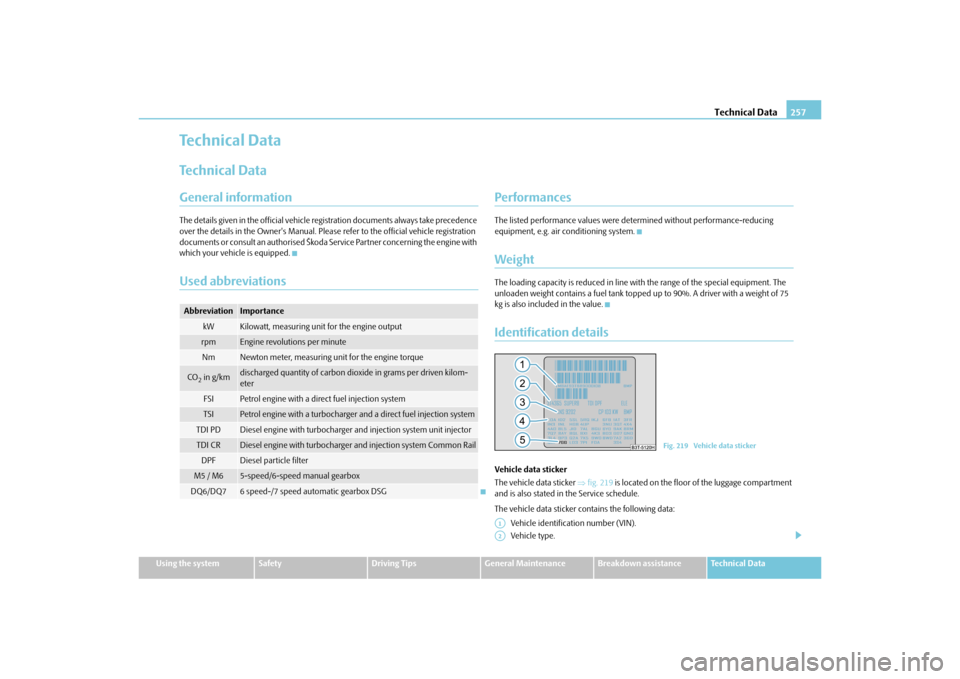
Technical Data257
Using the system
Safety
Driving Tips
General Maintenance
Breakdown assistance
Technical Data
Te c h n i c a l D a t aTechnical DataGeneral informationThe details given in the official vehicle regi stration documents always take precedence
over the details in the Owner's Manual. Please refer to the official vehicle registration
documents or consult an authorised Škoda Service Partner concerning the engine with
which your vehicle is equipped.Used abbreviations
PerformancesThe listed performance values were de termined without performance-reducing
equipment, e.g. air conditioning system.WeightThe loading capacity is reduced in line with the range of the special equipment. The
unloaden weight contains a fuel tank topped up to 90%. A driver with a weight of 75
kg is also includ ed in the value.Identification detailsVehicle data sticker
The vehicle data sticker fig. 219 is located on the floor of the luggage compartment
and is also stated in the Service schedule.
The vehicle data sticker co ntains the following data:
Vehicle identification number (VIN).
Vehicle type.
Abbreviation
Importance
kW
Kilowatt, measuring unit for the engine output
rpm
Engine revolutions per minute
Nm
Newton meter, measuring unit for the engine torque
CO2 in g/km
discharged quantity of carbon dioxide in grams per driven kilom-
eter
FSI
Petrol engine with a direct fuel injection system
TSI
Petrol engine with a turbocharger and a direct fuel injection system
TDI PD
Diesel engine with turbocharger and injection system unit injector
TDI CR
Diesel engine with turbocharger and injection system Common Rail
DPF
Diesel particle filter
M5 / M6
5-speed/6-speed manual gearbox
DQ6/DQ7
6 speed-/7 speed automatic gearbox DSG
Fig. 219 Vehicle data sticker
A1A2
s3fg.2.book Page 257 Friday, April 30, 2010 12:17 PM
Page 264 of 287
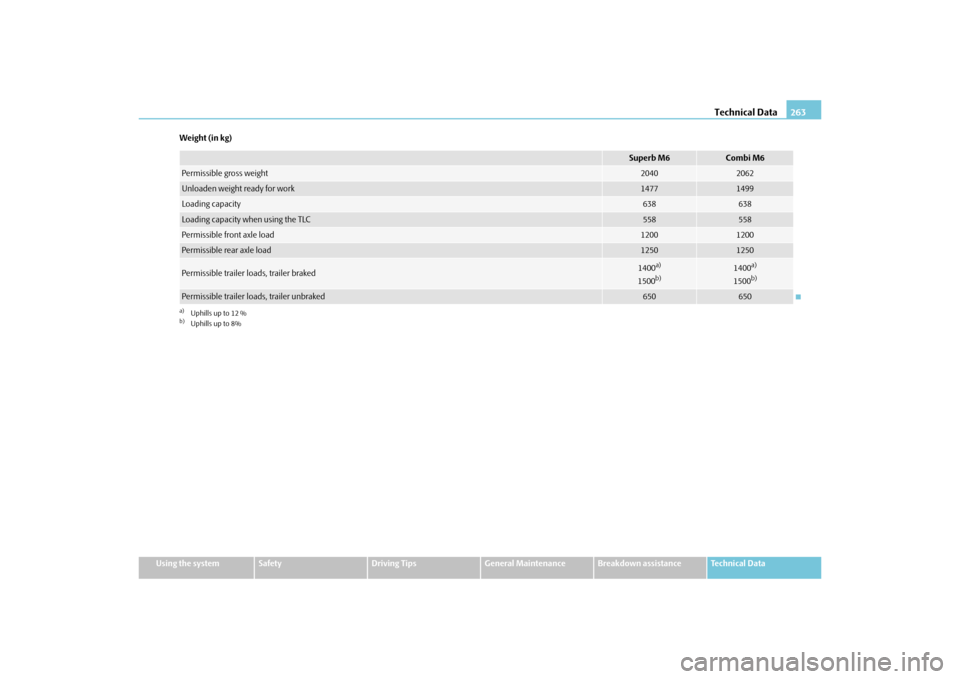
Technical Data263
Using the system
Safety
Driving Tips
General Maintenance
Breakdown assistance
Technical Data
Weight (in kg)
Superb M6
Combi M6
Permissible gross weight
2040
2062
Unloaden weight ready for work
1477
1499
Loading capacity
638
638
Loading capacity when using the TLC
558
558
Permissible front axle load
1200
1200
Permissible rear axle load
1250
1250
Permissible trailer loads, trailer braked
1400
a)
1500b)
a)Uphills up to 12 %b)Uphills up to 8%
1400
a)
1500b)
Permissible trailer loads, trailer unbraked
650
650
s3fg.2.book Page 263 Friday, April 30, 2010 12:17 PM
Page 266 of 287
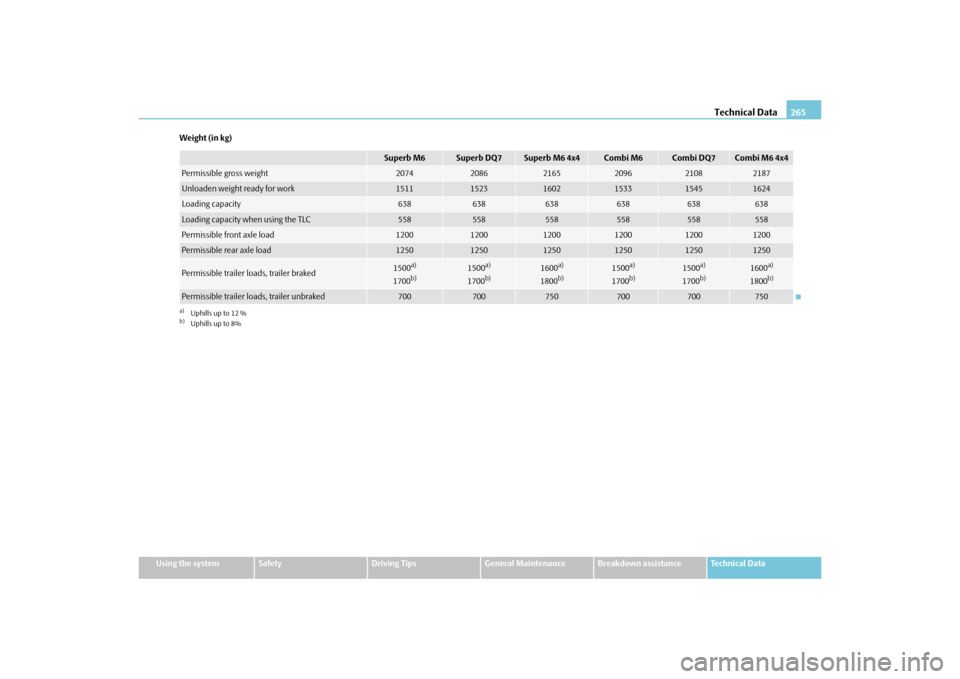
Technical Data265
Using the system
Safety
Driving Tips
General Maintenance
Breakdown assistance
Technical Data
Weight (in kg)
Superb M6
Superb DQ7
Superb M6 4x4
Combi M6
Combi DQ7
Combi M6 4x4
Permissible gross weight
2074
2086
2165
2096
2108
2187
Unloaden weight ready for work
1511
1523
1602
1533
1545
1624
Loading capacity
638
638
638
638
638
638
Loading capacity when using the TLC
558
558
558
558
558
558
Permissible front axle load
1200
1200
1200
1200
1200
1200
Permissible rear axle load
1250
1250
1250
1250
1250
1250
Permissible trailer loads, trailer braked
1500
a)
1700b)
a)Uphills up to 12 %b)Uphills up to 8%
1500
a)
1700
b)
1600
a)
1800b)
1500
a)
1700b)
1500
a)
1700
b)
1600
a)
1800b)
Permissible trailer loads, trailer unbraked
700
700
750
700
700
750
s3fg.2.book Page 265 Friday, April 30, 2010 12:17 PM
Page 268 of 287
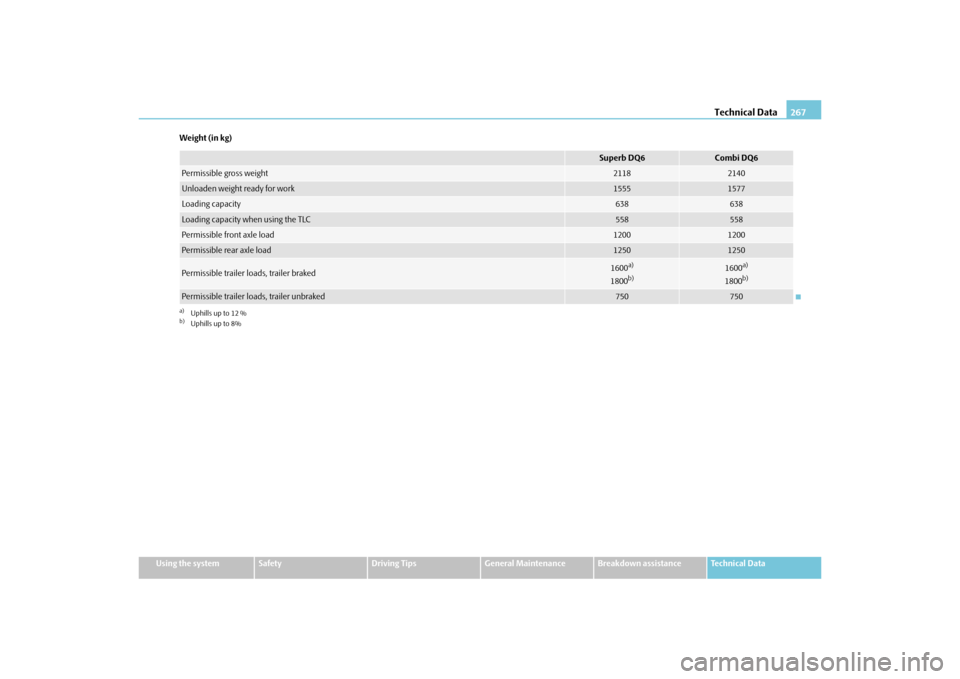
Technical Data267
Using the system
Safety
Driving Tips
General Maintenance
Breakdown assistance
Technical Data
Weight (in kg)
Superb DQ6
Combi DQ6
Permissible gross weight
2118
2140
Unloaden weight ready for work
1555
1577
Loading capacity
638
638
Loading capacity when using the TLC
558
558
Permissible front axle load
1200
1200
Permissible rear axle load
1250
1250
Permissible trailer loads, trailer braked
1600
a)
1800
b)
a)Uphills up to 12 %b)Uphills up to 8%
1600
a)
1800
b)
Permissible trailer loads, trailer unbraked
750
750
s3fg.2.book Page 267 Friday, April 30, 2010 12:17 PM
Page 270 of 287
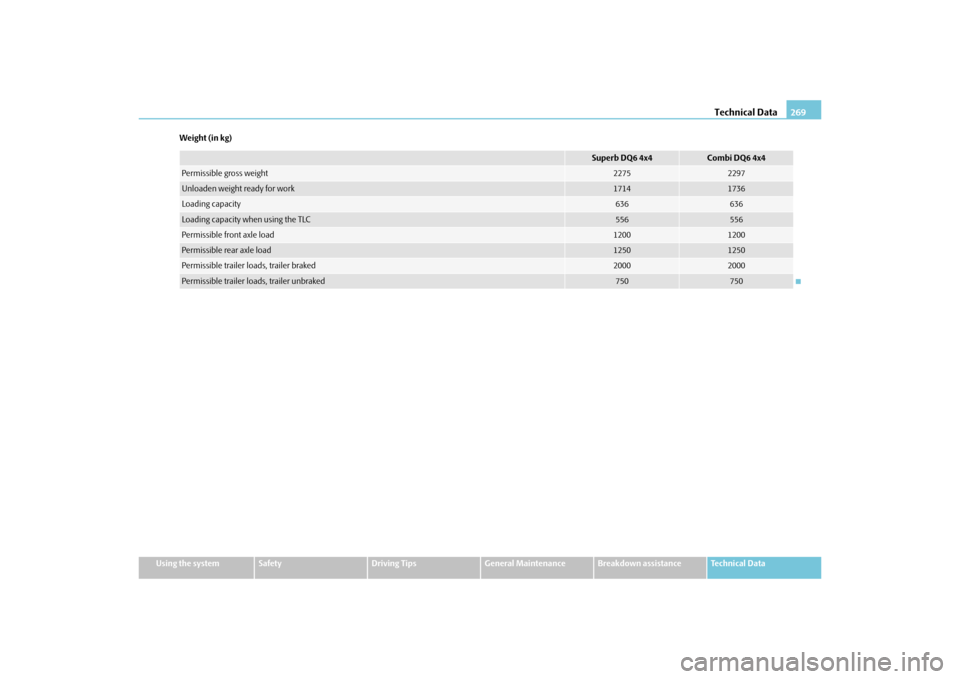
Technical Data269
Using the system
Safety
Driving Tips
General Maintenance
Breakdown assistance
Technical Data
Weight (in kg)
Superb DQ6 4x4
Combi DQ6 4x4
Permissible gross weight
2275
2297
Unloaden weight ready for work
1714
1736
Loading capacity
636
636
Loading capacity when using the TLC
556
556
Permissible front axle load
1200
1200
Permissible rear axle load
1250
1250
Permissible trailer loads, trailer braked
2000
2000
Permissible trailer loads, trailer unbraked
750
750
s3fg.2.book Page 269 Friday, April 30, 2010 12:17 PM
Page 272 of 287
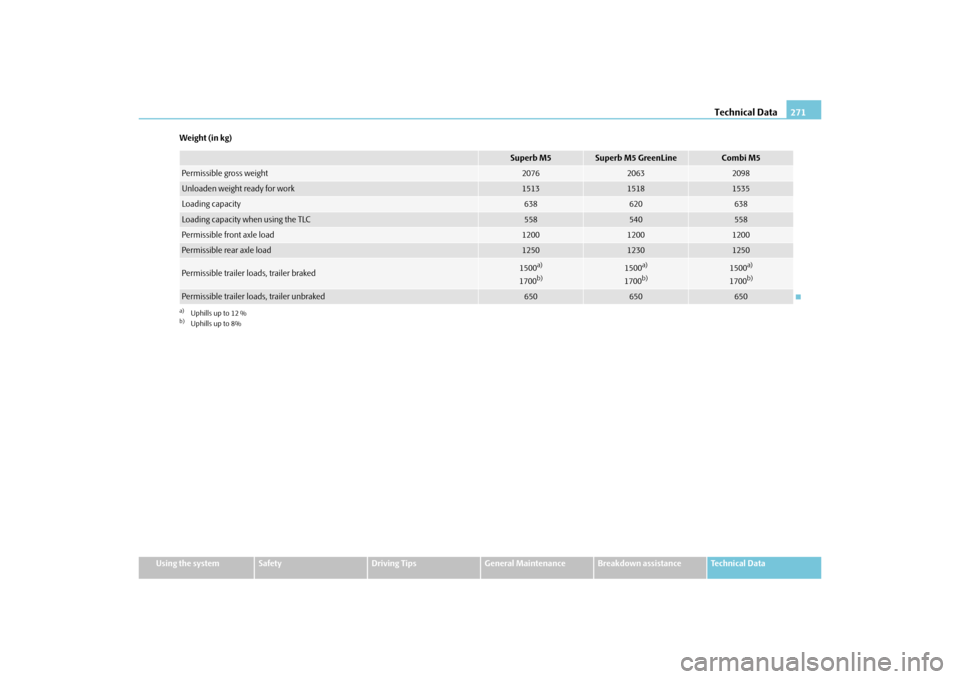
Technical Data271
Using the system
Safety
Driving Tips
General Maintenance
Breakdown assistance
Technical Data
Weight (in kg)
Superb M5
Superb M5 GreenLine
Combi M5
Permissible gross weight
2076
2063
2098
Unloaden weight ready for work
1513
1518
1535
Loading capacity
638
620
638
Loading capacity when using the TLC
558
540
558
Permissible front axle load
1200
1200
1200
Permissible rear axle load
1250
1230
1250
Permissible trailer loads, trailer braked
1500
a)
1700b)
a)Uphills up to 12 %b)Uphills up to 8%
1500
a)
1700b)
1500
a)
1700b)
Permissible trailer loads, trailer unbraked
650
650
650
s3fg.2.book Page 271 Friday, April 30, 2010 12:17 PM
Page 274 of 287
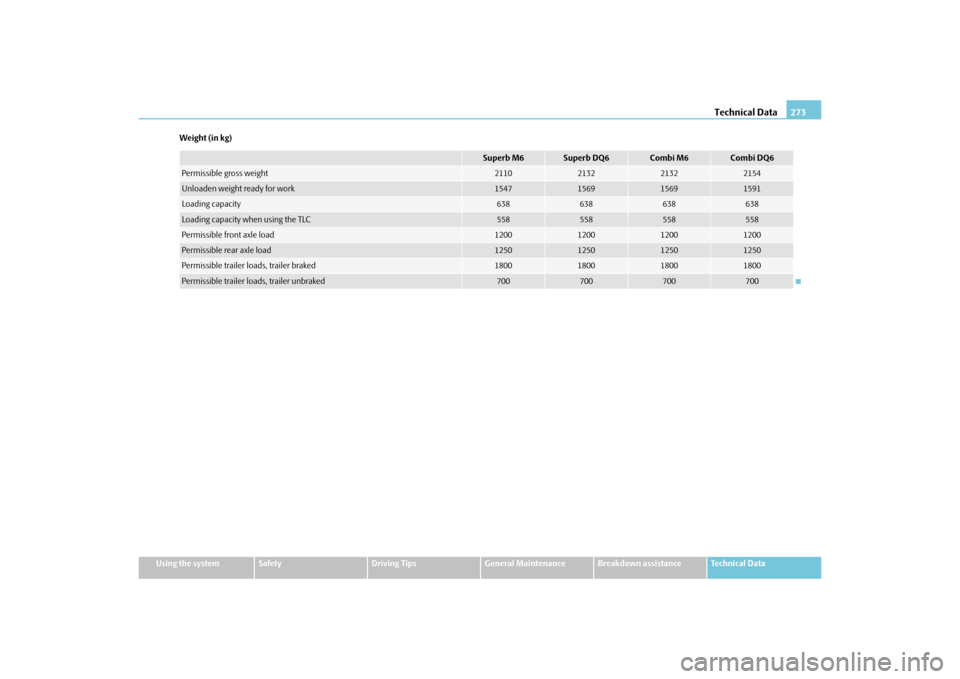
Technical Data273
Using the system
Safety
Driving Tips
General Maintenance
Breakdown assistance
Technical Data
Weight (in kg)
Superb M6
Superb DQ6
Combi M6
Combi DQ6
Permissible gross weight
2110
2132
2132
2154
Unloaden weight ready for work
1547
1569
1569
1591
Loading capacity
638
638
638
638
Loading capacity when using the TLC
558
558
558
558
Permissible front axle load
1200
1200
1200
1200
Permissible rear axle load
1250
1250
1250
1250
Permissible trailer loads, trailer braked
1800
1800
1800
1800
Permissible trailer loads, trailer unbraked
700
700
700
700
s3fg.2.book Page 273 Friday, April 30, 2010 12:17 PM